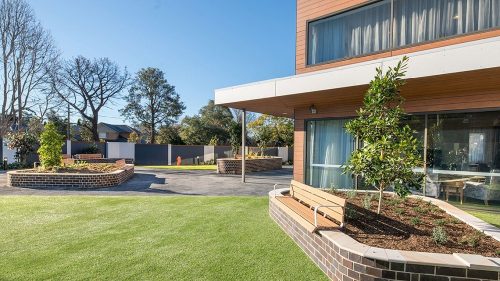Architecture in an aged care setting
April 11, 2018 | Aged Care Management
Architecture is not just a physical setting
Without giving it much thought, we live and work in a physical setting that influences us and what takes place within it. Winston Churchill said it simply:
“We shape our buildings and afterwards our buildings shape us.”
When designing aged care facilities, we shape the buildings that ultimately influence the mindset, health and wellbeing of staff, residents and their relatives. Small design decisions such as the view from the room, the layout of the building or the interior design are vital for the people who live and work there everyday.
Architecture affects people’s health and wellbeing
By impacting human senses, architecture affects our wellbeing and healing. Over the years, a lot of robust research in this area has been conducted – here are some examples of how architecture impacts human health:
- A view of nature may decrease pain by eliciting positive emotions, reducing stress and distracting patients from focusing on their pain (Ulrich et al., 2008).
- Time spent in light during the day can affect how the elderly sleep at night, achieving deeper sleep with fewer interruptions and less movement (Wallace-Guy et al., 2002).
- Patients in bright rooms consumed 22% less painkillers and had significantly lower scores of self-reported stress after an operation (Walch et al., 2005).
Building design has a well documented effect on human health and wellbeing, demonstrating that architecture can affect us as emotional beings – both in a positive and negative way. The method used to incorporate evidence in the design process is called ”evidence based design”.
Factbox
“Evidence based design is a method, where decisions about architecture, exterior and interior design are based on a systematic and transparent use of the best evidence available. (Weiss, 2018)“
Australian aged care facilities
 According to Pernille Weiss, expert in health architecture and founder of ArchiMed, a health architecture consultancy in Copenhagen, Australian aged care facilities can benefit from the use of evidence based design. Ms Weiss states:
According to Pernille Weiss, expert in health architecture and founder of ArchiMed, a health architecture consultancy in Copenhagen, Australian aged care facilities can benefit from the use of evidence based design. Ms Weiss states:
“Using evidence in the design process when building or rebuilding Australian aged care facilities can not only benefit the end user but also the facility’s operational budget.”
Furthermore the process has the ability to make the interaction between architecture and people more transparent.
“The process of evidence based design also improves the understanding of the interaction between people and walls throughout the lifetime of the building,” Ms Weiss said.
So the next time you are designing, building, renovating or considering an aged care facility for yourself or a loved one, ask yourself the question, “How does the building, and the interior design, impact the health and wellbeing of residents and those supporting them?”
And look for evidence supporting what you hope for yourself or your loved one. That’s how we impact the shape of the buildings that shape us.
 Guest author: Julie Bangsbo
Guest author: Julie Bangsbo
Julie Bangsbo Myrup specialises in the connection between health and architecture, with a focus on evidence-based health design. With a Masters degree in Public Health, she is co-author of the book “The ABC of Health Architecture”.
Julie was a consultant at Mirus Australia, providing analysis and education to Australian aged care facilities, with a focus on revenue and change management. She recently returned to her native country of Denmark and is currently employed by the Danish Ministry of Health.
References
- Churchill, W. (1943). We Shape Our Buildings. http://www.winstonchurchill.org/learn/speeches/quotations
- Ulrich, R.S., Zimring, C., BArch, X.Z., DuBose, J., Seo, H., Choi, Y., Quan, X., and Joseph, A. (2008). A Review of the Research Literature on Evidence-Based Healthcare Design. Health Environments Research & Design.
- Wallace-Guy, G., Kripke, D., Jean-Louis, G., Langer, R., Elliott, J., & Tuunainen, A. (2002). Evening light exposure: Implications for sleep and depression. Journal of the American Geriatrics Society, 50(4), 738.
- Walch, J. M., Rabin, B. S., Day, R., Williams, J. N., Choi, K., & Kang, J. D. (2005). The effect of sunlight on post-operative analgesic medication usage: A prospective study of spinal surgery patients. Psychosomatic Medicine, 67, 156.
- Weiss, P. (2018). The ABC of health architecture. ArchiMed.
- All images are of Bupa St Ives, 120 Killeaton St, St Ives NSW 2075.


